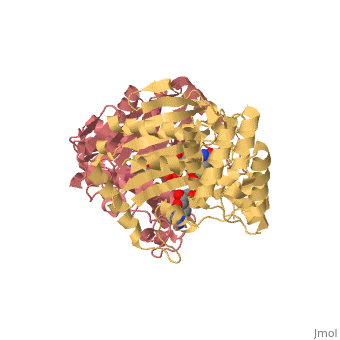2x06
SULFOLACTATE DEHYDROGENASE FROM METHANOCALDOCOCCUS JANNASCHIISULFOLACTATE DEHYDROGENASE FROM METHANOCALDOCOCCUS JANNASCHII
Structural highlights
Function[COMC_METJA] Catalyzes the reduction of sulfopyruvate to (R)-sulfolactate much more efficiently than the reverse reaction. Also catalyzes the reduction of oxaloacetate, alpha-ketoglutarate, and to a much lower extent, KHTCA, but not pyruvate. Involved in the biosynthesis of both coenzyme M (with (R)-sulfolactate) and methanopterin (with alpha-ketoglutarate). Evolutionary Conservation Check, as determined by ConSurfDB. You may read the explanation of the method and the full data available from ConSurf. Publication Abstract from PubMedThe crystal structure of the sulfolactate dehydrogenase from the hyperthermophilic and methanogenic archaeon Methanocaldococcus jannaschii was solved at 2.5 A resolution (PDB id. 1RFM). The asymmetric unit contains a tetramer of tight dimers. This structure, complexed with NADH, does not contain a cofactor-binding domain with 'Rossmann-fold' topology. Instead, the tertiary and quaternary structures indicate a novel fold. The NADH is bound in an extended conformation in each active site, in a manner that explains the pro-S specificity. Cofactor binding involves residues belonging to both subunits within the tight dimers, which are therefore the smallest enzymatically active units. The protein was found to be a homodimer in solution by size-exclusion chromatography, analytical ultracentrifugation and small-angle neutron scattering. Various compounds were tested as putative substrates. The results indicate the existence of a substrate discrimination mechanism, which involves electrostatic interactions. Based on sequence homology and phylogenetic analyses, several other enzymes were classified as belonging to this novel family of homologous (S)-2-hydroxyacid dehydrogenases. Methanoarchaeal sulfolactate dehydrogenase: prototype of a new family of NADH-dependent enzymes.,Irimia A, Madern D, Zaccai G, Vellieux FM EMBO J. 2004 Mar 24;23(6):1234-44. Epub 2004 Mar 11. PMID:15014443[1] From MEDLINE®/PubMed®, a database of the U.S. National Library of Medicine. References
|
| ||||||||||||||||||||
